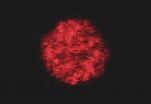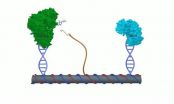(Press-News.org) Researchers reveal that neurons can utilize a supremely localized internal store of calcium to initiate the secretion of neuropeptides, one class of signaling molecules through which neurons communicate with each other and with other cells. The study appears in The Journal of General Physiology.
Neuropeptides are released from neurons through a process that—like other secretory events—is triggered primarily by the influx of calcium into the neuron through voltage-gated channels. Although neuropeptides are stored in large dense core vesicles (LDCVs) that also contain large amounts of calcium, it has been unclear whether these locally based calcium supplies can also be used to modulate secretion.
A team of researchers led by José Lemos from the University of Massachusetts Medical School examined the mechanisms at play during secretion of vasopressin from nerve terminals in the posterior pituitary gland, which releases the neuropeptide into the blood so that it can make its way to the kidney and regulate water retention. The researchers found that certain intracellular calcium channels known as ryanodine receptors are likely responsible for mobilizing calcium from LDCVs to facilitate vasopressin release. The findings indicate that neurons have a greater capacity than previously appreciated to fine-tune the release of neuropeptides and thereby their communications with other cells.
INFORMATION:
McNally, J.M., et al. 2014. J. Gen. Physiol. doi:10.1085/jgp.201311110
About The Journal of General Physiology:
Founded in 1918, The Journal of General Physiology (JGP) is published by The Rockefeller University Press. All editorial decisions on manuscripts submitted are made by active scientists in conjunction with our in-house scientific editor. JGP content is posted to PubMed Central, where it is available to the public for free six months after publication. Authors retain copyright of their published works and third parties may reuse the content for non-commercial purposes under a creative commons license. For more information, please visit http://www.jgp.org.
Research reported in the press release was supported by the National Institutes of Health, the University of Massachusetts Medical School, and the National Research Service Award.
Neurons can use local stores for communication needs
2014-05-26
ELSE PRESS RELEASES FROM THIS DATE:
Fighting cancer with dietary changes
2014-05-26
(PHILADELPHIA) -- -- Calorie restriction, a kind of dieting in which food intake is decreased by a certain percentage, has been touted as way to help people live longer. New research suggests that there may be other benefits, including improving outcomes for women in breast cancer. According to a study published May 26th in Breast Cancer Research and Treatment, the triple negative subtype of breast cancer – one of the most aggressive forms – is less likely to spread, or metastasize, to new sites in the body when mice were fed a restricted diet.
"The diet turned on a ...
Novel drug target linked to insulin secretion and type 2 diabetes treatment
2014-05-26
This news release is available in French. A signal that promotes insulin secretion and reduces hyperglycemia in a type 2 diabetes animal model is enhanced by the inhibition of a novel enzyme discovered by CHUM Research Centre (CRCHUM) and University of Montreal researchers. The team is part of the Montreal Diabetes Research Center and their study, published recently in Cell Metabolism, was directed by researchers Marc Prentki and Murthy Madiraju.
Insulin is an important hormone in our body that controls glucose and fat utilization. Insufficient insulin release by the ...
Promising approach to slow brain degeneration in a model of Huntington's disease uncovered
2014-05-26
This news release is available in French. Research presented by Dr. Lynn Raymond, from the University of British Columbia, shows that blocking a specific class of glutamate receptors, called extrasynaptic NMDA receptors, can improve motor learning and coordination, and prevent cell death in animal models of Huntington disease. As Huntington disease is an inherited condition that can be detected decades before any clinical symptoms are seen in humans, a better understanding of the earliest changes in brain cell (neuronal) function, and the molecular pathways underlying ...
The Lancet Oncology: UN officials warn refugees are struggling to access cancer treatment
2014-05-26
A study published in The Lancet Oncology journal reveals a high demand for costly cancer treatment among refugees from the recent conflicts in Iraq and Syria, with host countries struggling to find the money and the medicine to treat their new patients. The findings have prompted calls from lead author Dr Paul Spiegel, the United Nations High Commissioner for Refugees (UNHCR) Chief Medical Expert, for innovative financing schemes to improve access to affordable high-quality cancer care for refugees.
In the first study of its kind, Spiegel and colleagues examined data ...
A new molecule for high-resolution cell imaging
2014-05-25
Like our own bodies, cells have their own skeletons called 'cytoskeletons' and are made of proteins instead of bones. These network-like structures maintain the cell's shape, provide mechanical support, and are involved in critical processes of the cell's lifecycle. The cytoskeleton is an object of intense scientific and medical research, which often requires being able to observe it directly in cells. Ideally, this would involve highly-fluorescent molecules that can bind cytoskeletal proteins with high specificity without being toxic to the cell. Publishing in Nature Methods, ...
DNA nanotechnology places enzyme catalysis within an arm's length
2014-05-25
VIDEO:
In the middle of a DNA scaffold is affixed a single strand of DNA, with NAD+ tethered to the end like a ball and string. ASU Professor Han Yan refers...
Click here for more information.
Using molecules of DNA like an architectural scaffold, Arizona State University scientists, in collaboration with colleagues at the University of Michigan, have developed a 3-D artificial enzyme cascade that mimics an important biochemical pathway that could prove important for future biomedical ...
Gene mutation found for aggressive form of pancreatic cancer
2014-05-25
Researchers at the University of California, San Diego School of Medicine have identified a mutated gene common to adenosquamous carcinoma (ASC) tumors – the first known unique molecular signature for this rare, but particularly virulent, form of pancreatic cancer.
The findings are published in the May 25 advance online issue of Nature Medicine.
Pancreatic cancer is the fourth leading cause of cancer-related death in the United States, with roughly 45,220 new cases diagnosed and more than 38,400 deaths annually. Both numbers are rising. ASC cases are infrequent, but ...
Mice with 'mohawks' help scientists link autism to 2 biological pathways in brain
2014-05-25
"Aha" moments are rare in medical research, scientists say. As rare, they add, as finding mice with Mohawk-like hairstyles.
But both events happened in a lab at NYU Langone Medical Center, months after an international team of neuroscientists bred hundreds of mice with a suspect genetic mutation tied to autism spectrum disorders.
Almost all the grown mice, the NYU Langone team observed, had sideways,"overgroomed" hair with a highly stylized center hairline between their ears and hardly a tuft elsewhere. Mice typically groom each other's hair.
Researchers say they ...
Buried fossil soils found to be awash in carbon
2014-05-25
MADISON, Wis. — Soils that formed on the Earth's surface thousands of years ago and that are now deeply buried features of vanished landscapes have been found to be rich in carbon, adding a new dimension to our planet's carbon cycle.
The finding, reported today (May 25, 2014) in the journal Nature Geoscience, is significant as it suggests that deep soils can contain long-buried stocks of organic carbon which could, through erosion, agriculture, deforestation, mining and other human activities, contribute to global climate change.
"There is a lot of carbon at depths ...
Study identifies how signals trigger cancer cells to spread
2014-05-25
May 25, 2014 — (Bronx, NY) — Researchers at Albert Einstein College of Medicine of Yeshiva University have discovered a signaling pathway in cancer cells that controls their ability to invade nearby tissues in a finely orchestrated manner. The findings offer insights into the early molecular events involved in metastasis, the deadly spread of cancer cells from primary tumor to other parts of the body. The study was published today in the online edition of Nature Cell Biology.
To migrate from a primary tumor, a cancer cell must first break through surrounding connective ...



